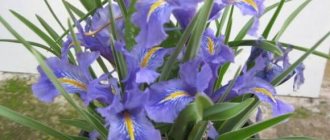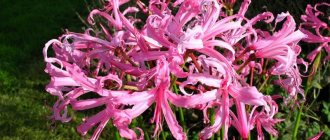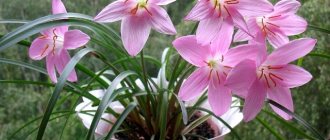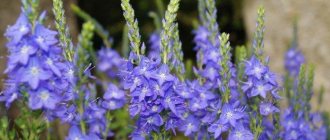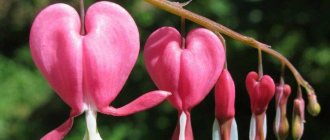Cleome is found throughout temperate climates. In total, the cleome genus unites several dozen plant species. In gardens, cleome is used as an ornamental plant. It has a characteristic inflorescence that looks like bursts of champagne. Growing cleome from seeds can be done both in spring and autumn.
Cleome flower: description
A plant from the cleome family reaches a height of up to one and a half meters and has straight, branched stems at the top, which, together with shoots and leaves, are covered with sticky hairs.
The light green leaves on long petioles are of different sizes - quite large closer to the ground, but very small at the top. They are dissected into 5–7 lobes and at the very base have stipules that form hard spines.
The flower did not get its name “champagne splashes” in vain. Four pink or white petals located on one side, and the stamens and pistil on the other, create a very unusual appearance, reminiscent of a splash of tiny droplets. Recently, varieties with yellow and blue flowers have also been developed. The inflorescences are very large - up to 20 cm in diameter. The smell of cleome is very unique and not everyone likes it, but it is of great importance for the plant: pollinating insects flock to it, and it is especially attractive to bees. In its homeland in the tropics, even small species of bats pollinate cleome.
When the flowers wither, seed pods are formed in their place, located on long legs and directed in different directions, thanks to which the plant becomes like a spider. In Germany and Great Britain this plant is often called the spider flower. The seeds are very small - in 1 gram you can count up to 400 of them. Cleome blooms for a long time - from June until frost.
Types of hatiora
In fact, the genus Hatiora is very small, and it includes only 4 species. They differ from each other in the shape of the segments, the color of the buds and the structure of the bush.
Saltwort hatiora
The same hatiora with thin elongated tube segments. Its bright green shoots actively branch and grow, and during the flowering season they are covered with small yellow bells.
Photo: pinterest.ru
Pink hathiora
Its segments are flat, wide and ribbed, 2-2.5 cm in length. The green tint is mixed with red and bluish, and occasionally the shoots are covered with prickly hairs. This is a very decorative species with large flowers up to 4 cm in diameter.
Photo: frauflora.ru
Hathiora Hermine
Another pink species with very bright flowers of medium size - up to 2.5 mm. This hatiora has long shoots that easily grow more than 30 cm. Moreover, the length of each segment reaches 5 cm.
Photo: rastenievod-007.blogspot.com
Hatiora Gartner
Its bright crimson or red buds are so richly colored that they are impossible to miss. They look especially impressive in contrast with dark, flat, jagged stems.
Photo: zen.yandex.ua
Hamedorea (50 photos): types, cultivation and care at home
Features of care
A rather unassuming plant is the champagne splash flower. Caring for it comes down to moderate watering and fertilizing, provided that the right area for planting is chosen. Cleome prefers sunny, warm and wind-protected places with neutral, fertile soil. Replanting for this flower is undesirable, so the choice of location should be taken seriously.
The plant should be watered as needed - if the soil dries out, because due to excess moisture, the flowers may lose all their decorative effect. After watering, the soil must be loosened. The plant does not require frequent feeding; it is enough to apply complex mineral fertilizer once every two weeks at the rate of 2 tablespoons per bucket of water. For weakened or diseased plants, you can spray the bush with a fertilizer solution (1 teaspoon per 3 liters of water) from a spray bottle.
“Splash of champagne” is a frost-resistant flower, so it does not require shelter for the winter. To make the flower more luxuriant, it is recommended to pinch the top, and spraying with zircon (1 ml per 1 liter of water) will help speed up flowering.
Characteristics
- Type: Succulent.
- Flower/fruit color: Pink, yellow, red.
- Leaf color: Green.
- Sun requirement: High.
- Size: 30-50 centimeters.
- Flowering: February-March.
- Aroma: Delicate, refined.
Whatever hatiora you choose, already in winter you will get a real “waterfall” of cascading flowers. In the cold season, they will look especially unusual in the room, as if reminding you of the approach of spring. Simple care and undemanding conditions will give you confidence if you decide to place this unusual plant in your home.
Procurement of seeds
Cleome reproduces exclusively by seeds. They are able to remain viable for up to 3 years.
The seeds are collected in the fall, when the pod ripens and opens easily when pressed. You can determine its degree of maturity by its color - it becomes darker. You cannot keep the seeds on the plant, because the pods, when ripe, burst and all their contents end up on the ground. To prevent this, you can place some of them in gauze bags in advance. Then, when the pod opens, the seeds will not fall on the ground, but will remain in the bag.
Growing cleome from seeds
Despite its tropical origin, the “champagne splash” flower grows quite well in central Russia. Propagation by seeds involves sowing them directly into open ground. But for early flowering of this plant it is better to use the seedling method. You need to start growing seedlings at the end of February. The seeds are first soaked for 12 hours in “Epin” (2 drops per glass of water) and then sown in a prepared container with a soil mixture prepared from humus, sand and garden soil. The same mixture is sprinkled on top and the container is covered with glass.
Reproduction methods
Hachiora is easy to propagate on your own. The procedure is best carried out in spring and summer, during active growth. There are several ways to do this:
- seeds;
- cuttings;
- vaccinations.
Propagation by seeds is the most labor-intensive and ineffective method. It is used mainly by breeders.
Cuttings
To root the plant, it is enough to break off a small part of the shoot, consisting of 3-4 segments.
It should be broken off by twisting at the thinnest point, where the barrel segments connect. Sprinkle the broken area with crushed coal. Then place the cuttings in a shaded place for a couple of days so that they dry out and then root. If you take a large fragment of a plant for rooting in order to immediately get a large flower, then it should be dried for at least a week. Some gardeners do not dry the cuttings, but place them in water. When they sprout roots they are planted.
The rooting substrate should be taken from a sand-peat mixture . Place the flower in a warm and bright place, protected from bright sun and drafts. Water with caution.
Hatiora takes root quickly. Sometimes fragile segments of the trunk can break off chaotically and, once on the soil, germinate on their own.
Graft
Reproduction by vegetative means or by grafting is a more troublesome method. It requires special skills and practice. But as a result, it produces a profusely flowering plant. It is better to graft Hatiora in the summer. As a rootstock you can take perexia spinosa.
The shoot of the rootstock, where there is a branched part, is cut off . At the point of branching, the trunk splits.
- Break off a stalk of 2-3 segments from the hatiora and sharpen its lower part.
- Then install the cutting with the pointed end instead of splitting the rootstock and secure.
- Once you are sure that the grafted plant has begun to grow, the fixing bandage can be removed.
- Place the plant in a sheltered place at a temperature of about 20°C.
The grafted plant takes root within 2-3 weeks.
Seedling care and planting
After 2 weeks, when the first shoots appear, the container with the seeds is placed in a well-lit place, periodically ventilated and moisten the soil as necessary. After the first pair of true leaves have formed on the sprouts, they can be planted in peat pots.
“Splash of champagne” is a flower that loves light very much, so in order to prevent the plants from stretching towards the sun, developing only in one direction, the pots need to be turned from time to time. Weak seedlings whose leaves are pale in color can be fed with complex fertilizer by dissolving 1 teaspoon in 3 liters of water.
Plants are planted in open ground after the end of frost, usually in early June. A suitable area is selected where there is enough light, which the “champagne splash” flowers love so much. Planting requires taking into account the features of landscape design. When digging, it is recommended to add rotted compost to the soil with the addition of flower fertilizer at the rate of 2 tablespoons per 1 square meter. meter.
Before planting seedlings, they must be sprayed with Epin solution. To prevent plantings from thickening in the future, contributing to the appearance of fungal diseases, pots with seedlings should be placed at a distance of at least 50 cm from each other. The planted plants are watered with a humate solution.
Use in landscape design
The cleome flower (“spray of champagne”) is widely used in the design of garden plots due to the ability to use it to decorate any barriers, structures and create all kinds of hedges. These flowers look impressive against the background of bright green plants and among low-growing flowers.
Cleome looks very beautiful in a composition with many plants - multi-colored phlox, rudbeckia, pink and white echinacea and other perennial and annual flowers. Due to the presence of thorns, it is not recommended to plant it in the foreground in flower beds or along paths.
A bouquet of these flowers can last in a vase for up to 15 days. To do this, they are cut off in the evening and, having removed the thorns, left in water in the fresh air overnight and only brought into the house in the morning. Cleome will not only fill the room with a pleasant aroma, but will also neutralize the air.
Hatiora – photo
How could we talk about such an unusual plant and not show it closer and from all angles? Just look how beautiful the hatiora is!
Photo: sadtem.ru
Photo: worldofsucculents.com
Photo: botanovod.com
Photo: nature-box.ru
Photo: worldofsucculents.com
Photo: consejosparamihuerto.com
Photo: sventameat.ru
Photo: nature-box.ru
Photo: sdelai-lestnicu.ru
Photo: kakteen-sukkulente.jimdofree.com
Photo: domashniecvety.ru
Photo: epig.org
Photo: worldofsucculents.com
Photo: avito.ru
Photo: klubrasteniy.ru
Photo: plant-identification.net
Photo: adenium-doma.ru
Photo: domashniecvety.ru
Photo: domashniecvety.ru
Photo: aliceliles.com
Photo: aliceliles.com
Photo: growotscholten.fotki.com
Photo: legkovmeste.ru
Did you like the post? Subscribe to our channel in Yandex.Zen, it really helps us in our development!
Indoor flower cleome
Usually this unusually beautiful annual is planted in garden plots. But if you follow certain rules for caring for this plant, then an indoor “champagne splash” flower may well become an interior decoration. Following simple agricultural practices allows you to admire its amazing flowers for several years.
To do this, it is necessary to bring the conditions of its maintenance closer to natural ones. Considering that the homeland of cleome is the tropics, it should be placed on the sunniest windowsills, and the air temperature in the apartment in the summer should not fall below 20⁰C. In winter, coolness is required - about 15⁰C. Regular spraying will create the moisture necessary for a tropical plant.
Otherwise, “champagne spray” flowers are quite unpretentious and hardy. Planting and caring for them does not cause any particular difficulties even for novice gardeners. It is enough to provide regular watering and fertilizing with regular fertilizer for indoor flowering plants.
Why doesn't it bloom and how to deal with it?
It happens that a plant does not bloom for several years. This usually happens because the flower does not have enough light. The location of the hatiora should be changed.
Also, the crop may not bloom if there is a lack of nutrients . In this case, the plant needs to be fertilized with phosphorus and potassium. These elements promote flowering.
Hatiora is a fairly accommodating and responsive indoor plant. If you provide it with normal conditions, then in due time numerous bell-shaped flowers will appear at the ends of the shoots.

